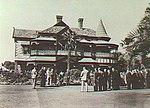Clayton Wesley Uniting Church
1856 establishments in AustraliaChurches completed in 1856Churches in AdelaideCongregational churches in AustraliaUniting churches in South Australia ... and 1 more
Use Australian English from August 2021

Clayton Wesley Uniting Church, formerly Clayton Congregational Church, is a church building in the Adelaide suburb of Beulah Park (historically located in Kensington), located on Portrush Road, in a commanding position at the eastern end of The Parade, Norwood, in South Australia. The current building with its tall spire was built was built in 1883, although an earlier building (still behind the present church and now known as the Lecture Hall) was built in 1856.
Excerpt from the Wikipedia article Clayton Wesley Uniting Church (License: CC BY-SA 3.0, Authors, Images).Clayton Wesley Uniting Church
The Parade, Adelaide Beulah Park
Geographical coordinates (GPS) Address External links Nearby Places Show on map
Geographical coordinates (GPS)
| Latitude | Longitude |
|---|---|
| N -34.9207 ° | E 138.6415 ° |
Address
Clayton Wesley Uniting Church
The Parade
5067 Adelaide, Beulah Park
South Australia, Australia
Open on Google Maps



